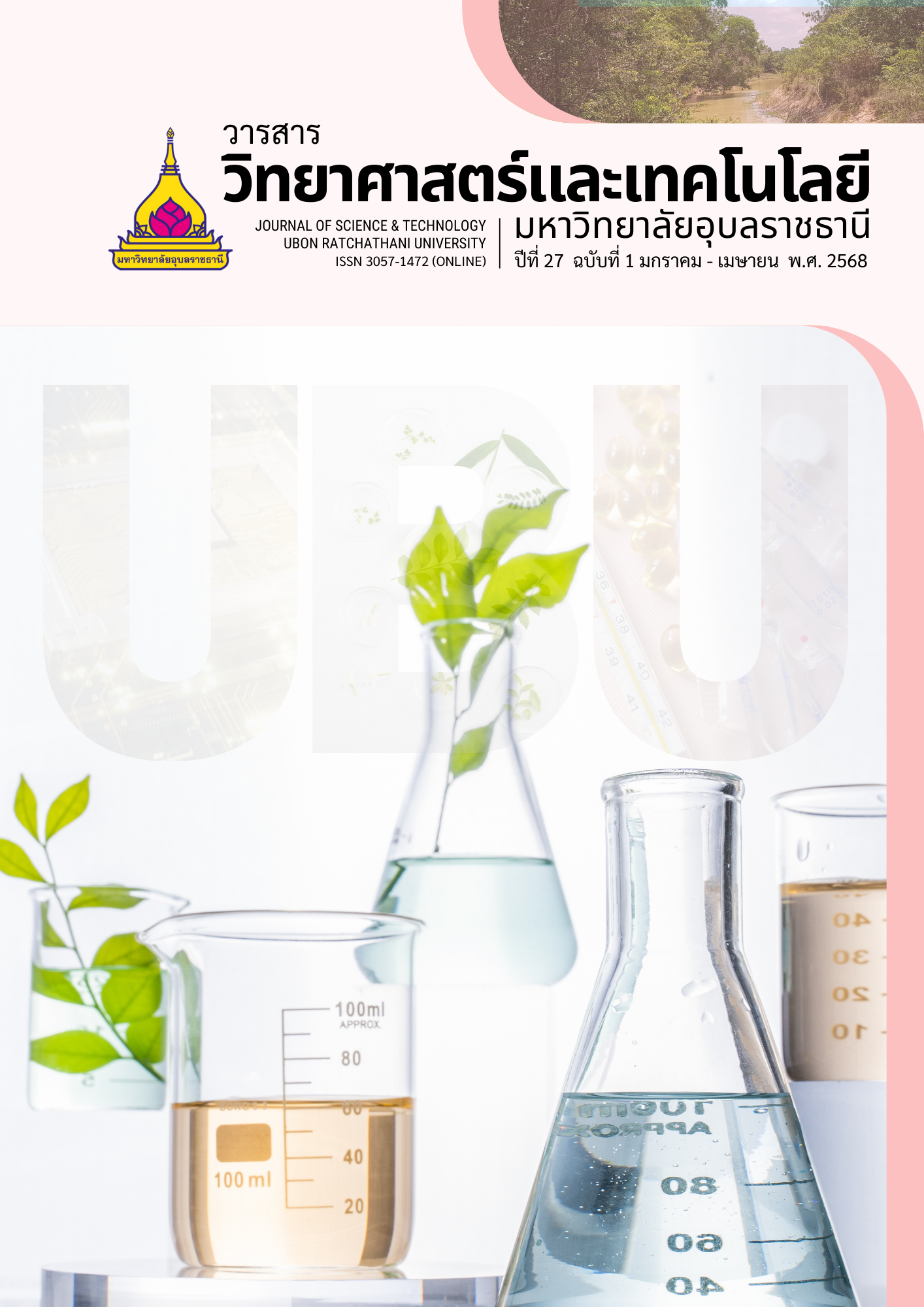ผลของวิธีการผลิตชาดอกบัวหลวงแดงต่อปริมาณฟีนอลิกรวม ปริมาณฟลาโวนอยด์รวม ฤทธิ์ต้านอนุมูลอิสระ และฤทธิ์ยับยั้งเอนไซม์อะซิติลโคลีนเอสเทอเรส
Main Article Content
บทคัดย่อ
ภาวะความรู้คิดบกพร่องเล็กน้อยในผู้สูงอายุมักสัมพันธ์กับความเสื่อมของระบบประสาทส่วนกลาง ซึ่งมีรายงานว่าเกิดจากการสะสมของอนุมูลอิสระ และการลดลงของอะซิติลโคลีน ด้วยเหตุนี้อาหารและเครื่องดื่มที่สามารถต่อต้านอนุมูลอิสระ และบำรุงสมอง เช่น ชาสมุนไพร จึงได้รับความนิยมมากขึ้นเรื่อย ๆ งานวิจัยนี้มีวัตถุประสงค์เพื่อศึกษาผลของวิธีการผลิตชาดอกบัวหลวงแดงต่อปริมาณฟีนอลิกรวม ปริมาณฟลาโวนอยด์รวม ฤทธิ์ต้านอนุมูลอิสระ และฤทธิ์ยับยั้งเอนไซม์อะซิติลโคลีนเอสเทอเรส ผลิตภัณฑ์ชาที่ใช้ในการศึกษานี้ได้จากวิธีการผลิต 3 วิธี ได้แก่ ชาที่ไม่ผ่านกระบวนการหมัก (ชา NF) ชากึ่งหมัก (ชา SF) และชาที่หมักอย่างสมบูรณ์ (ชา CF) จากการศึกษาพบว่าชา CF มีปริมาณฟีนอลิกรวมสูงที่สุด เท่ากับ 8.77 ± 0.21 มิลลิกรัมสมมูลของกรดแกลลิกต่อกรัมของชาอบแห้ง ชา SF มีปริมาณฟลาโวนอยด์รวมสูงที่สุด เท่ากับ 3.38 ± 0.12 มิลลิกรัมสมมูลของเคอร์ซิตินต่อกรัมของชาอบแห้ง การศึกษาฤทธิ์ต้านอนุมูลอิสระ ABTS•+ และ DPPH• แสดงให้เห็นว่าชา CF มีค่า half-maximal inhibitory concentration (IC50) ดีที่สุด เท่ากับ 1.89 ± 0.02 และ 0.15 ± 0.01 มิลลิกรัมต่อมิลลิลิตร ตามลำดับ และจากการศึกษาฤทธิ์ยับยั้งเอนไซม์อะซิติลโคลีนเอสเทอเรส พบว่าชา CF มีค่า IC50 ดีที่สุด เท่ากับ 2.62 ± 0.73 มิลลิกรัมต่อมิลลิลิตร จากที่กล่าวมาข้างต้น จะเห็นได้ว่าผลิตภัณฑ์ชาดอกบัวหลวงแดง โดยเฉพาะชาที่หมักอย่างสมบูรณ์มีฤทธิ์ทางชีวภาพ เช่น ฤทธิ์ต้านอนุมูลอิสระ และฤทธิ์ยับยั้งเอนไซม์อะซิติลโคลีนเอสเทอเรส ผลิตภัณฑ์ชาดังกล่าวจึงมีศักยภาพที่จะนำไปต่อยอดในเชิงพาณิชย์ได้ในอนาคต
Article Details

อนุญาตภายใต้เงื่อนไข Creative Commons Attribution-NonCommercial-NoDerivatives 4.0 International License.
บทความที่ได้รับการตีพิมพ์เป็นลิขสิทธิ์ของ วารสารวิทยาศาสตร์และเทคโนโลยี มหาวิทยาลัยอุบลราชธานี
ข้อความที่ปรากฏในบทความแต่ละเรื่องในวารสารวิชาการเล่มนี้เป็นความคิดเห็นส่วนตัวของผู้เขียนแต่ละท่านไม่เกี่ยวข้องกับมหาวิทยาลัยอุบลราชธานี และคณาจารย์ท่านอื่นๆในมหาวิทยาลัยฯ แต่อย่างใด ความรับผิดชอบองค์ประกอบทั้งหมดของบทความแต่ละเรื่องเป็นของผู้เขียนแต่ละท่าน หากมีความผิดพลาดใดๆ ผู้เขียนแต่ละท่านจะรับผิดชอบบทความของตนเองแต่ผู้เดียว
เอกสารอ้างอิง
Department of Older Persons (DOP). 2023. General Older Persons’ Information. https://www.dop.go.th/th/know/1. Accessed 13 January 2024. (in Thai)
Economic and Social Commission for Asia and the Pacific (ESCAP). 2022. ESCAP Population Data Sheet 2022. https://www.unescap.org/kp/2022/2022-escap-population-data-sheet. Accessed 13 January 2024.
Eshkoor, S.A. and et al. 2015. Mild cognitive impairment and its management in older people. Clinical Interventions in Aging. 10: 687-693.
Pharanwit, A. 2021. Dementia. Regional Health Promotion Center 9 Journal. 15(37): 392-398. (in Thai)
Liguori, I. and et al. 2018. Oxidative stress, aging, and diseases. Clinical Interventions in Aging. 13: 757-772.
Chen, X. and Zhang, Y. 2024. A review of the neurotransmitter system associated with cognitive function of the cerebellum in Parkinson’s disease. Neural Regeneration Research. 19(2): 324-330.
Aryal, S. and et al. 2019. Total phenolic content, flavonoid content and antioxidant potential of wild vegetables from Western Nepal. Plants. 8(4): 96.
Saengkhae, C., Arunnopparat, W. and Sungkhajorn, P. 2007. Antioxidative activity of the leaf of Nelumbo nucifera Gaertn. on oxidative stress-induced erythrocyte hemolysis in hypertensive and normotensive rats. Thai Journal of Physiological Sciences. 20(2): 70-78.
Ahmed, H. and et al. 2019. A review of the important pharmacological activities of Nelumbo nucifera: A prodigious rhizome. International Journal of Biomedical and Advance Research. 10(01): e5007.
Prabsattroo, T. and et al. 2016. Positive modulation of pink Nelumbo nucifera flowers on memory impairment, brain damage, and biochemical profiles in restraint rats. Oxidative Medicine and Cellular Longevity. 2016: 5789857.
Ravichandran, R. and Parthiban, R. 1998. The impact of processing techniques on tea volatiles. Food Chemistry. 62(3): 347-353.
Deb, S. and Jolvis, K.R. 2016. A review of withering in the processing of black tea. Journal of Biosystems Engineering. 41(4): 365-372.
Roshanak, S., Rahimmalek, M. and Goli, S.A. 2016. Evaluation of seven different drying treatments in respect to total flavonoid, phenolic, vitamin C content, chlorophyll, antioxidant activity and color of green tea (Camellia sinensis or C. assamica) leaves. Journal of Food Science and Technology. 53(1): 721-729.
Feng, Z. and et al. 2019. Tea aroma formation from six model manufacturing processes. Food Chemistry. 285: 347-354.
Ohnon, W. and et al. 2019. The combined extract of black sticky rice and dill improves poststroke cognitive impairment in metabolic syndrome condition. Oxidative Medicine and Cellular Longevity. 2019: 9089035.
Luximon-Ramma, A. and et al. 2002. Antioxidant activities of phenolic, proanthocyanidin, and flavonoid components in extracts of Cassia fistula. Journal of Agricultural and Food Chemistry. 50(18): 5042-5047.
Sriset, Y. and et al. 2021. In vitro antioxidant potential of Mallotus repandus (Willd.) Muell. Arg stem extract and its active constituent bergenin. Songklanakarin Journal of Science and Technology. 43(1): 24-30.
Blois, M.S. 1958. Antioxidant determinations by the use of a stable free radical. Nature. 181(4617): 1199-1200.
Ellman, G.L. and et al. 1961. A new and rapid colorimetric determination of acetylcholinesterase activity. Biochemical Pharmacology. 7(2): 88-95.
Zargar, B. and et al. 2018. Effect of different processing parameters on antioxidant activity of tea. Journal of Food Measurement and Characterization. 12: 527-534.
Pasrija, D. and Anandharamakrishnan, C.J. 2015. Techniques for extraction of green tea polyphenols: A review. Food and Bioprocess Technology. 8: 935-950.
Roshanak, S., Rahimmalek, M. and Goli, S.A. 2016. Evaluation of seven different drying treatments in respect to total flavonoid, phenolic, vitamin C content, chlorophyll, antioxidant activity and color of green tea (Camellia sinensis or C. assamica) leaves. Journal of Food Science and Technology. 53(1): 721-779.
Deb, S. and Jolvis, K.R. 2016. A review of withering in the processing of black tea. Journal of Biosystems Engineering. 41(4): 365-372.
Yoshino, K. and et al. 1994. Antioxidative effects of black tea theaflavins and thearubigin on lipid peroxidation of rat liver homogenates induced by tert-butyl hydroperoxide. Biological and Pharmaceutical Bulletin. 17(1): 146-149.
Tan, Q. and et al. 2019. Structure-activity relationship analysis on antioxidant and anticancer actions of theaflavins on human colon cancer cells. Journal of Agricultural and Food Chemistry. 67(1): 159-170.
Tungmunnithum, D. and et al. 2018. Flavonoids and other phenolic compounds from medicinal plants for pharmaceutical and medical aspects: An overview. Medicines. 5(3): 93.
Bendary, E. and et al. 2013. Antioxidant and structure-activity relationships (SARs) of some phenolic and anilines compounds. Annals of Agricultural Sciences. 58(2): 173-181.
Gardner, E.J. and et al. 2007. Black tea - helpful or harmful? A review of the evidence. European Journal of Clinical Nutrition. 61(1): 3-18.
Thennakoon, T. and et al. 2022. Total phenolic content, total flavonoid content and in vitro antioxidant activities measured by the FRAP, ABTS, DPPH and ORAC assays of Sri Lankan black and green tea (Camellia sinensis) infusions. Food Biology. 11: 1-10.
Zargar, B. and et al. 2018. Effect of different processing parameters on antioxidant activity of tea. Journal of Food Measurement and Characterization. 12: 527-534.
Ha, S. and Park, S. 2006. Glutamate-induced oxidative stress, but not cell death, is largely dependent upon extracellular calcium in mouse neuronal HT22 cells. Neuroscience letters. 393(2-3): 165-169.
Saraswathi, K. and et al. 2019. Antioxidant and antidiabetic activities of fresh aqueous pink petals of Indian lotus-Nelumbo nucifera Gaertn. Journal of Drug Delivery and Therapeutics. 9(5): 82-88.
Chen, R. and et al. 2002. Role of cholinergic signaling in Alzheimer’s disease. Molecules. 27(6): 1816.
Temviriyanukul, P. and et al. 2020. The effect of sacred lotus (Nelumbo nucifera) and its mixtures on phenolic profiles, antioxidant activities, and inhibitions of the key enzymes relevant to Alzheimer’s disease. Molecules. 25(16): 3713.


